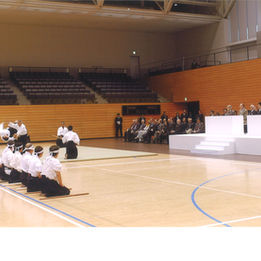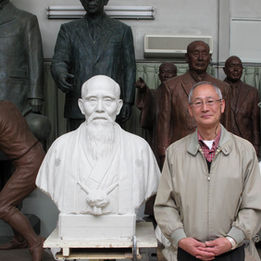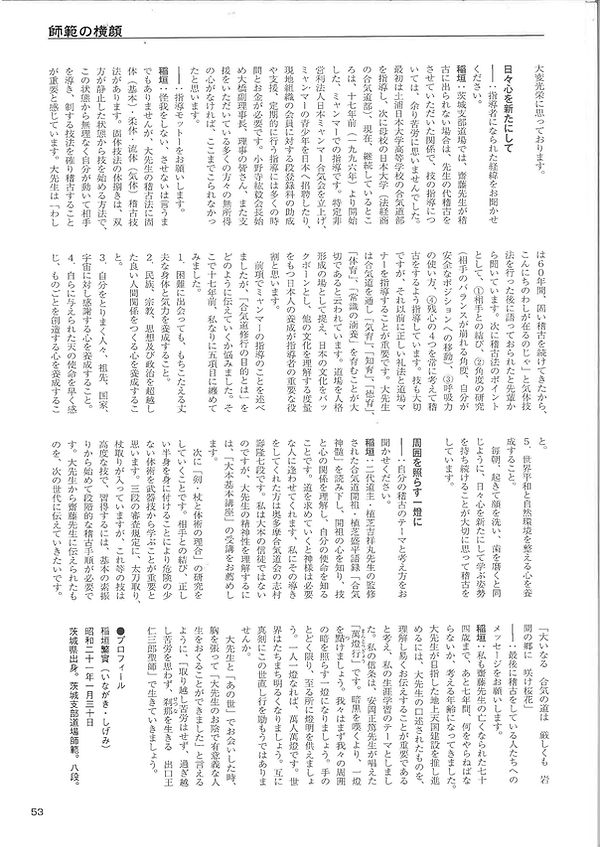Biography of Master Inagaki
1945 Before the end of the war, his parents evacuated Iwama-cho from Ota-ku, Tokyo.
1946 Born in Iwama-cho, Nishi-Ibaraki-gun (now Kasama-shi), Ibaraki Prefecture
1958 Entered Aiki-jinja Dojo (now Ibaraki Branch Dojo)
Founder 74 years old, Saito Sensei 30 years old, Isoyama Hiroshi Sensei 21 years old
1964 Entered the Nihon University College of Commerce and joined the Aikido Club.
1969 Graduated from the same university, and trained as an uchideshi under Saito Sensei at the Ibaraki Branch Dojo for two and a half years.
Founder passed away in April, Saito Sensei was 41 years old (working for Japan National Railways).
In 1974, he accompanied Saito Sensei to a training session in San Francisco.
1976 (age 30) Accompanied Saito Sensei again to San Francisco, Los Angeles, and Hawaii.
1996 (age 50) Began working with the youth of Myanmar through aikido.
2002 (age 56) Established the non-profit organization “Myanmar Aikikai Japan”.
2004 (age 58) Invited by the Myanmar government to the National Military Memorial Day Dinner
36 times of teaching in Myanmar country by 2019
2008 (age 62) Demonstrated aikido in Tsukuba City in front of the Emperor and Empress and the King and Queen of Spain
By 2025, overseas seminars will be held in 15 countries (USA, Brazil, Uruguay, Argentina, New Zealand, Myanmar, Russia, Sweden, Denmark, England, Germany, Poland, Bulgaria, Italy, Spain).


Inagaki Shihan Interview,
Aikido Tankyu
.jpg)
Issue 46 (Pages 52 and 53) ISBN78-4-88293-452-3
July 20. 2013
Shihan Profile 29
Ibaraki Branch Dojo Teaching Staff Shihan, Shigemi Inagaki 8th Dan
Training in Iwama
-
Please let us hear about how you encountered aikido.
Inagaki: I enrolled at the dojo attached to the Aiki Shrine (the present day Ibaraki Branch Dojo) in Showa 33 (1958) when I was twelve years old, fifty five years previous from now. It was an era of wanting strength and boys in those times were looking at manga and movies such as ‘Akado Suzonosuke’, ‘Kurama Tengu’ and ‘Sarutobi Sasuke.’
There was a rumour among us children that an aikido instructor could neatly climb across the ceiling like a ninja, so I became very interested and got an introducer, and was allowed to brush my name into the enrolment register. I was waiting in the anteroom before practice began and Osensei sat down in the doorframe between the dojo and the anteroom, having just finished his dinner. I took the chance to ask “Osensei, can you climb across the ceiling?” Osensei’s reply was “That wasn’t me.” When we had the Grand Festival of the Aiki Shrine, I saw a person called Bo Fujita, escaping from ropes tied around his body and limbs like a ninja, climbing and doing a trick, cutting a daikon (white, Oriental radish) with a katana on his stomach.
-
Please tell us your memories of the training, and lasting impressions of the teachers and sempai (seniors) from those times.
Inagaki: Osensei lived in the dojo (24 tatami mats) and the four-tatami living room and bedroom that connected to it by a corridor, along with an uchi deshi (live-in student), Mr Nishiuchi, while Morihiro Saito (deceased) and his wife, who already lived in the present location, took care of Osensei and his wife. Training was in the regular adults’ class between 7 and 8pm.
Isoyama Sensei, my dai-sempai (great senior), enrolled in Showa 24 (1949) at the age of 12, and at the time I enrolled he was serving at the koku-jieitai (air self-defence force) base in Chitose. When he occasionally returned home, his keiko was severe stuff. In summer we would clear away the tatami mats, put them in the corner and train on the bare floorboards. I have severe memories of the skin coming off my knees and them suppurating. Many of the sempai were self-employed farmers and they didn’t have the machinery that we have now, so they were in good condition from growing crops through human toil. In addition to that, Saito Sensei had practiced karate before beginning aikido, so under his influence we built makiwara (rice-straw striking pads) in our homes to forge our fists, hand-blades and so on and we did tanren (forging training) by taking yokomen (side-of-head) strikes with the bokken (wooden training sword) on our bared arms.
I think people who had trained in other dojos might have felt this training was severe. Two years after entering the dojo, I received shodan (first degree black belt) and the number on my certificate was 723, so I don’t think that there were many people practicing aikido in the world.
-
Please give us your memory of the founder.
Inagaki: After we had finished taiso (physical exercises) that included chinkon-gyo (return to spirit training), Nishi Health System exercises and makko-ho (Japanese yoga), Osensei would make us listen to a long speech before starting keiko. At that time it sounded like gibberish, but now, when I read “Aiki Shinzui” and “Takemusu Aiki”, the fragments of it remain in my ears as my memory resurfaces from those days. Osensei’s teaching method began first with tai-no-henko and when starting from katatedori, we would continuously do kanrenwaza (related techniques) from katatedori, and rather than “ki-no-nagare”(flowing techniques), Osensei would make grabbing strongly the centre of the practice. I think his feeling was to pass on something received from the gods, so when showing the next technique, he would say “mōshi-agemasu” (“I humbly offer”) without using the word to ‘teach.’
In about Showa 41 or 42 (1966 or 1967), I came home from university and there was a Taiwanese magazine company covering Osensei. Saito Sensei and the seniors were not available, so my younger brother (Ryuji Sawa 7th dan) and I were Osensei’s otomo (assistants) up on Mt. Atago, and when taking photographs, we brothers took ukemi (break-falls) for Osensei barefoot on the ice needles of the precincts.
From the autumn of Showa 44 (1969), the year the founder passed away, I was allowed to train as an uchi deshi for up to two and a half years. The main work was cutting the grass in the grounds around the dojo. When Saito Sensei came home from night duty, we would get black all over with sweat and dirt and fought a hard battle with grass-burn and the wasps. The grounds were vast, so no sooner had we finished and cleared one half than the other side was in a bad way again, so it really was endless work.
After the founder passed away, the second Doshu, Kisshomaru Sensei would come on the 14th of each month and ‘tsukinamisai’ (monthly festival) was held. When tsukinamisai had finished, we would gather with Kisshomaru Sensei for‘naorai’ (Shinto partaking of food offerings) and in those days there were not so many people, so we were able to talk with him. Even if he drank a lot of sake, he didn’t lose his posture and when he was merry, we would listen to him singing ‘shinsengumi’ songs. Due to this, I was honoured by his attendance at my wedding reception (Showa 47 – 1972).
Day by Day, Refresh the Mind
-
Please let us hear about the circumstances in which you became an instructor.
Inagaki: I didn’t think I had any trouble in the Ibaraki Branch Dojo when Saito Sensei was unable to attend keiko and I had to teach in his place. At first, I taught at Tsuchiura Nihon University High School’s aikido club, next was my alma mater, Nihon University’s Law, Economics and Commerce Department aikido club, and in present times, I am ongoing with my instruction in Myanmar, which began seventeen years ago (1996). It took a lot of time and money to create the NPO Nihon Myanmar Aikikai, inviting young people from Myanmar to Japan, getting subsidies and backing for dan-registration in relation to the local organisation and occasionally going to instruct. Without the generosity of our president, Koki Onodera, vice-chief director Ohashi, all of our directors, and support from everyone, I don’t think we would have come this far.
-
Please tell us your instructor motto.
Inagaki: It goes without saying, not to get injured or injure others, and in Osensei’s training method, there are kotai [or ‘katai’ solid] (basic), jutai [soft], ryutai [flowing] and kitai [aeriform] techniques. In the tai sabaki (body placement) of kotai, through the method of beginning from a situation in which both parties are still, one moves oneself without wastage and leads the opponent and I think it is very important to train firmly in the this method. I once heard a story from my sempai that after training in basic techniques, Osensei said, “I am who I am now because I practised solid form continuously for 60 years.”
Next, as points for keiko-ho (training method):
1) Connection (musubi) to one’s opponent
2) The study of angles (the angle at which one’s opponent is unbalanced as well as moving oneself into a position in which one is safe)
3) The way of using kokyu-ryoku (abdominal breath power)
4) Zanshin (the ‘remaining spirit’)
These are the four things that I teach one to habitually consider during training. Techniques are also important, but before that it is essential to teach correct etiquette and dojo manners. It is said that Osensei considered it important to foster ‘ki-iku’ (ki training), ‘chi-iku’ (intellectual training), ‘toku-iku’ (moral training), ‘tai-iku’ (physical education) and ‘jo-shiki no kanyo’ (the cultivation of common sense) through aikido. By considering the dojo as a place for character-building, and taking Japanese culture as a backbone, I think the cultivation of Japanese people who possess the magnanimity to understand other cultures, is a crucial role to instil in instructors.
Regarding the instruction in Myanmar, which I mentioned in the previous section, I was troubled by how to convey “the purpose of aikido is...” Accordingly, I summarized this myself in five points, 17 years ago.
-
The cultivation of a robust body and will that will endure hardship
-
The cultivation of good human relations, transcending race, religion, ideology as well as politics
-
The cultivation of a thankful heart for the people around oneself, one’s ancestors, one’s country and the universe
-
The cultivation of a creative mind that senses early ones mission granted from above
-
The cultivation of a heart that fosters world peace and the natural environment
Every morning, I get up, wash my face and clean my teeth and just like this, day after day, I think it is important to maintain an attitude of learning with a fresh mind when training.
The Lantern that Illuminates its Surrounds
-
Please tell us about your own theme and way of thinking regarding training
Inagaki: Fully reading the analects of the founder, Morihei Ueshiba, compiled by the second Doshu Kisshomaru Sensei in “Aikido Shinzui”, gives us knowledge of the mind of the founder, understanding the relationship between technique and the mind, and knowledge of one’s own calling. When you seek the way, the kami will allow you to meet the person you need, and the one who led me was Toshitaka Shimura, 7th dan, of Okutama Aikido-Kai. I am not a follower of Omoto, but to understand Osensei’s spirituality, I recommend taking up lectures in the ‘Omoto Basic Course.’
Next is the study of the union of principles (riai) between the sword, the jo (staff) and taijutsu (unarmed ‘body methods’). I think it is essential to learn low-danger taijutsu by acquiring a connection with one’s opponent and correct hanmi (half-body posture) from weapons. Tachi-dori (sword-taking) and jo-dori (staff-taking) are stipulated in the 3rd degree black-belt test requirements, but to master these high-level techniques, one must progress step-by-step, beginning with practicing the basic suburi (practice cuts). I would like to pass on what was passed down from Osensei to Saito Sensei for the next generation. As austere as it is, “Although the great way of aiki is severe, cherry blossoms bloom in the village of Iwama.”
-
Finally, could you give us a message for everyone who is training?
Inagaki: In seven years time, I too will reach the 74 years of age that Saito Sensei passed away at, and I have come to an age at which I think about what I am supposed to do.
To advance the establishment of heaven on earth that Osensei was aiming for, I think the passing on of his dictations in a way that is easy to understand is imperative, and I have made this a theme in my lifelong learning. My belief is in the ‘mantogyo’(“10,000 Lanterns”) recited by Masahiro Yasuoka. Rather than grieve over the darkness, light a single lantern. Be a light which illuminates the darkness around us. As far as the hand can reach, offer the light everywhere. If every single person becomes a single lantern we will have mantogyo. Let the world become illuminated at once. Shall we not endeavour to do this in order to reform the world?
When you see Osensei on the ‘other side’, in order to be able to puff out your chest and say, “Thanks to you, I was able to have a meaningful life,” let’s live by Onisaburo Deguchi’s words: “Don’t think about the passing hardships, live for the moment.”
Profile
Shigemi Inagaki
Born: 30th January, Showa 21 (1946)
Ibaraki Branch Dojo Shihan, 8th Dan

















-1_%E3%83%9A%E3%83%BC%E3%82%B8_2.jpg)
-1_%E3%83%9A%E3%83%BC%E3%82%B8_1.jpg)